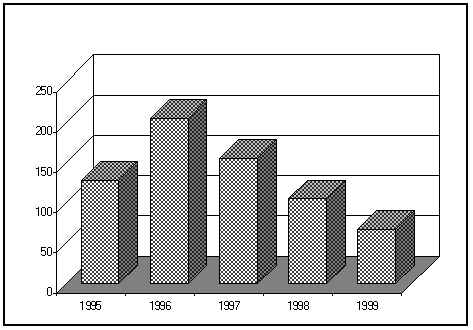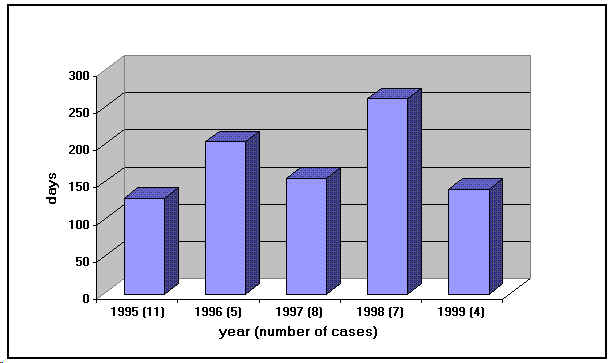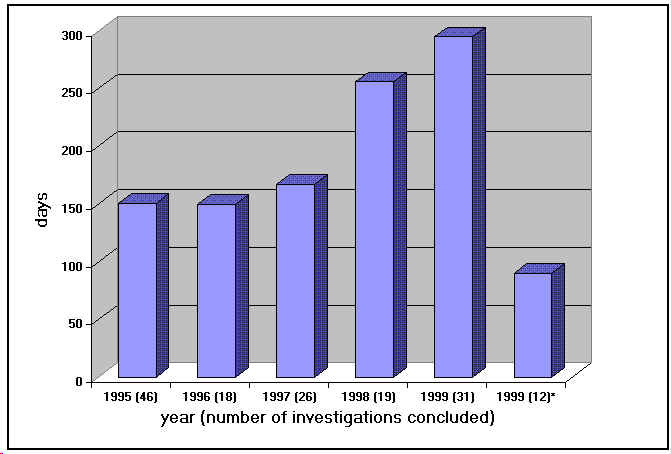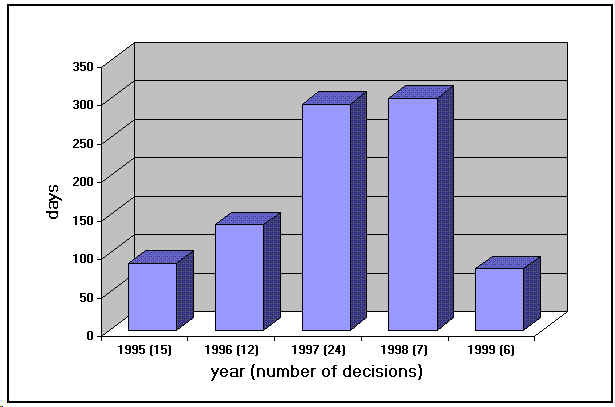Alaska Labor Relations Agency 1999 Annual Report
Submitted March 2000 (In accordance with AS 23.05.370)
Introduction
- Personnel
- Board Members (For 1999 Annual Report)
- Staff
- Office
- Statutes
- Regulations
Highlights
- Case load comparison by year
- Overview
- Charts
- Representation Petitions
- Strike and Strike Class Petitions
- Unit Clarification Petitions
- Unfair Labor Practice Charges
- Comparison by ULP complainant
- Claims for Religious Exemption
- Petitions to Enforce the Collective Bargaining Agreement
Timeliness
- Elections
- Unfair Labor Practice Investigations
- Decision and Orders
Decision and Orders Issued
Introduction
The Alaska Labor Relations Agency administers the Public Employment Relations Act (PERA) for the State, municipalities, public schools, and university. The Agency also administers the railroad labor relations laws for the Alaska Railroad Corporation. It determines petitions for certification or decertification of bargaining representatives, petitions to clarify the composition of public employee bargaining units and to amend the certification of units, and charges of unfair labor practices from labor organizations, public employers, and public employees. It enforces terms of a collective bargaining agreement, determines strike eligibility of workers, and rules on claims for religious exemption from the obligation to pay fees to a bargaining representative.
BOARD MEMBERS back to top
The agency is governed by a board of six members who serve staggered three-year terms. The members must have backgrounds in labor relations and two members each must be drawn from management, labor, and the general public. AS 23.05.360(b).
STAFF
back to top
Mark Torgerson, hearing
examiner/administrator
Jean Ward, hearing officer/investigator
Margie Yadlosky, personnel specialist I
Donna Bodkin, administrative clerk III
OFFICE
back to top
3301 Eagle Street, Suite 208
P.O. Box 107026
Anchorage, Alaska 99510-7026
Phone: (907) 269-4895
Fax: (907) 269-4898
https://labor.alaska.gov/laborr/
STATUTES
back to topRelevant statutes appear in AS 23.05.360--23.05.390; AS 23.40.070--23.40.260 (PERA); and AS 42.40.705--42.40.890 (railroad).
Pamphlet No. 900
REGULATIONS
back to topThe agency's regulations appear in 8 AAC 97.010--8 AAC 97.990.
Pamphlet No. 900
Back to Labor Relations || Summary || Contents
Highlights
For the first time in several years, the Agency did not experience turnover in any of its four staff positions. This stabilizing of personnel, along with streamlined procedures, enabled the Agency to put a significant dent in a caseload backlog that had developed in the mid-1990's. Although a backlog still exists, total pending cases have decreased in each of the past two years due to efficiencies of operations.
Cases filed in 1999 totaled 68, a reduction from 106 in 1998 and 156 in 1997. This 36 percent decrease, coupled with an increase in dispositions of previously pending cases, reduced the agency's total caseload significantly. The total 1999 filings are more comparable to the average number of filings (84) during the 1991 to 1994 period. The Agency's backlog developed in primary part due to the large number of cases filed in the 1995-to-1998 period, an average of 149 per year. Due to a lean budget, the agency continued to work this large caseload increase with the same number of staff.
Unit clarification (UC) petitions totaled 31 in 1999, the largest category of cases filed. This compares to 66 filings in 1998. These petitions usually concern the supervisory status of various State employees. The supervisory status of an employee determines the employee's bargaining unit placement. While the question of who is a supervisor affects all State employee bargaining units, UC disputes before the Agency primarily involve the State, the Alaska State Employees Association (ASEA), (which represents the general government unit,) and the Alaska Public Employees Association (APEA), which represents the supervisors' unit. A significant increase in the number of petitions began in 1995, due in part to a 1995 amendment to a regulation defining "supervisory employee." The validity of this amendment was eventually challenged in the courts. On October 15, 1999, the Alaska Supreme Court affirmed the regulation's validity.
The UC caseload had increased to 207 by November 1, 1997. The procedure at that time, holding a hearing in each case, became essentially impossible. To reduce the UC caseload backlog and improve production, the agency implemented streamlining procedures, which have succeeded so far. In 1999, the agency completed 93 UC investigations. Coupled with the 31 cases filed during the year, the UC caseload was reduced significantly in 1999. (See "Final Disposition" data in chart at page 8, and discussion at page 14).
Filings in unfair labor practice (ULP) charges experienced a slight decrease from 22 in 1998 to 20 in 1999. The issue in 45 percent of the charges was bad faith bargaining. These charges often arise in the context of collective bargaining; one party believes the other party is not bargaining in good faith. The issue in 30 percent of the charges was interference with protected rights such as organizing and collective bargaining. The remaining 25 percent of charges related to the duty of fair representation.
The Agency's efforts to deal with the increasing unit clarification caseload delayed completion of unfair labor practice investigations. Effective January 1, 1999, the Agency implemented new investigative procedures designed to reduce the time needed to complete investigations. Because this procedure affects only newly filed cases, and not charges filed in prior years, the number of days to conclude all investigations (see chart at page 18) may continue to rise until pre-1999 cases are completed. Applying old procedures, the Agency completed 19 ULP investigations in an average of 424 days. This compares to 12 ULP cases completed under the new, more efficient procedure in an average of 90 days.(See chart at page 18).
The Agency received four election petitions in 1999. One petition requested certification of a bargaining representative, another requested decertification, and two others sought decertification of the current representative and certification of a new bargaining representative.
The Agency also conducted three elections. Two of the elections certified new bargaining units, and one election decertified the bargaining representative. The outcome of the election activity in 1999 was a net decrease in the number of public employees covered by collective bargaining.
The number of strike petitions increased for the third year in a row. Total 1999 strike petitions were 6, compared to 4 in 1998 and 2 in 1997. This increase is generally attributable to expiration of multi-year contracts between employers and labor organizations.
The Agency continues to encourage informal resolution of disputes. As a result, 18 unfair labor practice charges were resolved informally in 1999. This compares to 15 such resolutions in 1998, 20 in 1997, and 14 in 1996. In addition, the Agency's hearing officer/investigator has worked with parties in structured mediation sessions to settle several unfair labor practice charges. This success in mediation saved the parties, the Board, and the Agency the cost and time that would have been required for litigation of the disputes. The Agency hopes to train other staff to assist in mediation efforts.
During 1999, the Agency helped to revitalize the Alaska chapter of the Industrial Relations Research Association (IRRA). IRRA is the one organization in the country in which professionals from all aspects of industrial relations and human resources can share ideas and learn about new developments and practices in the field. IRRA sponsors and publishes research. It promotes education and provides a forum for the exchange of ideas on employment issues. IRRA does not take partisan positions on policy issues; rather, it serves as a resource to labor and management professionals, including advocates and neutrals, government, and the academic community. An active Alaska chapter provides Alaska employment professionals with opportunities for networking and training, and it serves as a resource within the state.
The Alaska chapter started meeting on a monthly basis in September, 1999. Meetings are highlighted by speaker presentations. In recent months, speakers have addressed issues such as arbitration, equal employment opportunity, and workplace violence and safety.
Agency information is available on its internet web site, accessible through the State of Alaska's home page (http://www.state.ak.us) or directly at https://labor.alaska.gov/laborr/. The site contains a link to contact the administrator by email, and information about agency programs and resources. The Agency continues to add new materials. For example, during 1999, digests of Agency decision and orders, along with a link to the full decision, were added for the years 1997-99. The Agency set a goal of having digests and decisions from 1991 (the agency's inception) to the present available on the web site by June 30, 2000.
CASE STATUS SUMMARIES back to top
Case Load Comparison by Year

*NC = not counted
Program Comparison by Year

RC Representation petitions / SP Strike notices and petitions / UC Unit
clarification petitions
ULP Unfair labor practice charge / RE Religious exemption claim / CBA Contract Enforcement
Employer Comparison by Year

REPRESENTATION PETITIONS (AS 23.40.100; AS 42.40.750) back to top
Representation petitions are filed by labor organizations, employers, or employees to initiate a secret ballot election for certification or decertification of an employee representative for collective bargaining. Less frequently a petition is filed to advise the agency that the employer consents to the labor organization's representation of a particular unit of employees. Notification of consent to recognition does not require any action by the Agency. Most petitioners seek an election. Before an election can be conducted, any objections to the election or the composition of the bargaining unit must be resolved. Often a hearing before the Agency is needed. Petitions for representation of a municipal bargaining unit frequently require examination of the validity of a municipality's rejection of PERA under the opt out clause in the legislation adopting PERA, section 4, ch. 113, SLA 1972. Employer objections to the unit that the labor organization seeks to represent also are common. The Agency conducts the election, rules on objections or challenges to the conduct of the election, and certifies the results. If the petitioner seeks to sever a group from an existing unit, the petitioner must demonstrate that the existing unit was not fairly representing the interests of the smaller group, and that the smaller group is an appropriate unit, among other factors.
The Agency conducted three elections in 1999. One election resulted in certification of the Laborers International Union of North America, Local 341/AFL-CIO, and International Union of Operating Engineers Local 302/AFL-CIO, as joint petitioners to represent public works/sewer and water department employees of the City of Whittier. In another representation election, the Agency certified the International Union of Operating Engineers Local 302/AFL-CIO as the representative of a unit of City of Unalaska. The third election was a decertification petition by Alaska State Court System employees represented by the International Brotherhood of Electrical Workers Local Union 1547, AFL-CIO. This election resulted in certification of no bargaining representative. In addition to these elections, the agency received one petition to amend an election certificate. It showed a bargaining unit name change from Alaska Housing Finance Corporation Employees Association to Alaska Housing Maintenance and Custodians, Local 6082/Alaska Public Employees Association/AFT, AFL-CIO.
The Agency also received a representation petition from a new employee association called the City of Fairbanks, General Government Employees Association. This petition seeks decertification of the current bargaining representative, Alaska Public Employees Association/AFT, AFL-CIO, and certification of the new employee association as the exclusive bargaining representative. A blocking charge (unfair labor practice) must first be resolved before this election can proceed.
Representation Petition Flow Chart
STRIKE & STRIKE CLASS PETITIONS FACE="Arial" SIZE="-1"> (AS 23.40.200; 8 AAC 97.300; AS 42.40.850) back to top
Public employees under PERA are divided into three classes, depending on their right to strike. Under PERA the agency hears disputes about strike classifications and impasse. It receives notices of strike vote election and monitors the election, which the labor organizations conduct themselves. The Agency rules on any objections to the conduct of elections. In the case of school district bargaining representatives, submission to advisory arbitration is required before a strike vote election. 8 AAC 97.300.
The number of strike petitions filed has tripled in the past three years, from two in 1997 to six in 1999. This is primarily attributable to expiration of multi-year collective bargaining agreements. In one case, employees of the Anchorage School District filed a strike vote petition that involved disputes between the Anchorage School District and support personnel represented by TOTEM Association of Educational Support Personnel, Inc. The Ketchikan Gateway Borough School District and the Lower Kuskokwim School District were also involved in strike vote petitions involving their teachers. The Ketchikan teachers resolved their contract dispute after a brief strike. Unions representing State of Alaska employees also filed three strike petitions, but they have not gone out on strike.
UNIT CLARIFICATION PETITIONS FACE="Arial" SIZE="-1"> (8 AAC 97.050) back to top
Unit clarification petitions and petitions to amend a bargaining unit can be filed to resolve disputes over unit composition. An employer's reorganization of its staff, or adding or eliminating positions can raise a question of the appropriate unit. Representation may not be an issue in a unit clarification petition, and unit issues that come up in the process of handling a representation petition are not counted here.
Most of these disputes arise as objections to State transfers between bargaining units. For example, the State may change a position's job duties, which may affect the position's unit placement. Transfers between the general government unit (GGU) and the supervisory (SU) or confidential (CEA) units comprise most of the disputes. If investigation shows there is reasonable cause to believe that a question of unit clarification exists, the cases require a hearing with the State and both interested labor organizations as parties.
Although the number of unit case filings in 1999 (31) decreased from 1998 (66), the average number of petitions filed annually in the 4-year period 1996-99 (85 per year) continues to challenge the Agency's resources. (By comparison, the number of unit petitions filed during the 1992-95 period averaged 22 per year.) Of the 31 unit clarification petitions filed in 1999, 30 were State-related petitions. Most result from the State's shift of employees to the supervisory unit from the general government unit following the Agency's 1995 amendment to the definition of "supervisory employee." The amendment, intended to simplify determining who is a supervisor, has been controversial. However, on October 15, 1999, the Alaska Supreme Court upheld the validity of the regulation defining "supervisory employee." (See "supervisory status" case under "Appeals" at page 21).
To address the significant rise in unit clarification cases, the agency implemented streamlining procedures in 1998. Caseloads were adjusted, and as a result, the personnel specialist I, rather than the hearing officer, now handles initial investigations. Moreover, the Agency now utilizes a comprehensive questionnaire to gather needed investigatory information, rather than rely on and wait for the parties to provide it, or proceed to hearing, as was done under prior procedures (For example, 28 UC disputes went to hearing in 1996). As a result of these new procedures, a total of 93 unit clarification investigations were concluded in 1999. At this time, 72 unit clarifications remain open. The Agency's hearing officer, who previously conducted these investigations, is only required to review and act on the personnel specialist's recommendations. This enables the hearing officer to focus more time on unfair labor practice investigations, mediation, and other duties.
UNFAIR LABOR PRACTICE CHARGES (AS 23.40.110; AS 42.40.760) back to top
Employers, employee representatives, and individual employees may file unfair labor practice charges. Charges against employers can include retaliation for union membership or exercise of employee rights, coercion, domination or interference with an organization, and bad faith bargaining. Charges against unions include coercion, bad faith bargaining, dues disputes, and interference with the employer's selection of its collective bargaining representative.
Unfair labor practice charge filings totaled 20 in 1999, compared to 22 in 1998 and 40 in 1997. The dispute in nine charges concerned bad faith bargaining. Six charges alleged interference with protected rights, and five concerned the duty of fair representation.
The Agency concluded 31 investigations in 1999, compared to 24 in 1998 and 26 in 1997. As noted (see "Highlights"), staff vacancies and the dramatic increase in the unit clarification caseload had impacted investigation, resolution and conclusion of unfair labor practice cases. The Agency had prioritized unit clarifications in order to gain an element of control over that caseload. Consequently, the time to conclude unfair labor practice investigations and issue decisions increased significantly in 1998. (See timeliness charts, page 18). As expected, this pattern continued into 1999 as the agency worked through the older pending cases. However, the Agency implemented a streamlined, more efficient unfair labor practice procedure effective January 1, 1999. This procedure has reduced the time needed to conclude investigations (See chart at page 18). Further (see page 12), unit clarifications have been reassigned to the personnel specialist I so the hearing officer has more time to devote to unfair labor practice charges.
Comparison by ULP Complainant
Unfair Labor Practice Charge Flow Chart
CLAIMS FOR RELIGIOUS EXEMPTION (AS 23.40.225; AS 42.40.880) back to top
AS 23.40.225 and AS 42.40.880 allow a public employee to seek an exemption from union membership or agency fee payment on the basis of religious convictions.
PETITIONS TO ENFORCE THE COLLECTIVE BARGAINING AGREEMENT (AS 23.40.210; AS 42.40.860(b); 8 AAC 97.510) back to top
AS 23.40.210 and AS 42.40.860(b) authorize the agency to enforce the terms of a collective bargaining agreement (CBA). Because all agreements under AS 23.40.210 must contain an arbitration clause to handle disputes under the agreement, 8 AAC 97.510 requires that parties first exhaust the arbitration clause or show that it does not apply before filing a petition with the agency to enforce the agreement.
Five such petitions were filed in 1999, one more than 1998's total, but equal to the average number of CBA petitions filed yearly in the 1993 - 1996 period. The 1997 period contained the highest number of CBA petitions filed (10).
Timeliness
ELECTIONS
Number of Days to Certification of Election

UNFAIR LABOR PRACTICE INVESTIGATIONS
Number of Days to Conclusion of Investigation

DECISION AND ORDERS
Number of Days from Closing of Record to Decision

Decisions and Orders Issued
1. Laborers International Union of North America Local 341, International Union of Operating Engineers Local 302, AFL-CIO vs. City of Whittier , Decision & Order No. 242 (03/03/1999). Excluding temporary employees from the bargaining unit of Department of Public Works (DPW) employees at the City of Whittier would cause unnecessary fragmentation. Under AS 23.40.090, the temporary employees share a sufficient community of interest with the permanent DPW employees to form an appropriate unit. The position occupied by Ben Leniz is not a supervisory position under 8 AAC 97.990(a)(5) and is included in the bargaining unit.
2 . State Of Alaska, Alaska Marine Hwy System vs. Inlandboatmen's Union of the Pacific, Alaska Region , Decision & Order No. 243 (04/09/1999). The IBU's delay in collective bargaining negotiations was not unreasonable because it had a right to delay the negotiating process to conduct a pre-impasse strike vote, under Inlandboatmen's Union of the Pacific v. State of Alaska, 3 AN-95-5882 CI (February 14, 1997).
3. Fairbanks Fire Fighters Association, IAFF Local 1324 vs. City of Fairbanks , Decision & Order No. 244 (06/08/1999). The dispute between the parties is subject to the arbitration procedure set forth in the parties' collective bargaining agreement.
4 . Alaska State Employees Association/AFSCME Local 52, AFL-CIO, vs. State of Alaska, Department of Administration, Division of Personnel/EEO, Decision & Order No. 245 (11/17/1999). Prior to impasse and absent necessity, a compelling business justification or contractual provisions to the contrary, the State violates AS 23.40.110(a)(5) and (a)(1) by implementing a unilateral change to a mandatory subject of bargaining, such as health benefit costs.
5. Alaska State Employees Association/AFSCME Local 52, AFL-CIO vs. State of Alaska, Department of Administration, Division of Personnel/EEO, Decision & Order No. 246 (12/16/1999). Prior to impasse and absent necessity, a compelling business justification or contractual provisions to the contrary, the State violates AS 23.40.110(a)(5) and (a)(1) by implementing a unilateral change to a mandatory subject of bargaining, such as health benefit costs. A decision will be affirmed when a reconsideration petition makes essentially the same arguments that were made in the underlying case.
6. Fairbanks Fire Fighters Association, Local 1324 IAFF, vs. City of Fairbanks, Decision & Order No. 247 (12/14/1999). A threat by the employer of legal action against an employee/union business agent for filing grievances is a violation of AS 23.40.110(a)(5) and (a)(1). The fact that the employer decided to include a so-called reservation of rights statement along with the threat does not diminish the effect of the threat of legal action for damages.
Appeals
SUPERVISORY STATUS. On July 7, 1998, the superior court affirmed the Agency's decision in State of Alaska v. Alaska State Employees Ass'n/AFSCME Local 52, AFL-CIO & Alaska Public Employees Ass'n/AFT, AFL-CIO , Decision & Order No. 219 (May 27, 1997). The superior court had previously remanded the matter for additional evidence, and to determine the validity of two agency regulations. Upon reviewing the evidence upon remand, and after a second hearing, the Agency concluded the incumbent employees (statewide environmental coordinator, technical engineer II/architect II, and natural resource manager I) were supervisors as defined in 8 AAC 97.990(a)(5). In addition, the Agency found valid its regulation requiring separate units for supervisors and non-supervisors (8 AAC 97.090(a)(1)), and the regulation defining "supervisory employee" (8AAC 97.990(a)(5)). Superior court Judge Rene Gonzalez agreed. (3AN-95-9083 CI). Among other things, Judge Gonzalez held that there is "no requirement that a state employee must have formal documentation of officially delegated responsibility to be a supervisor." The court also found the agency's reliance on employees' opinions of their own authority was appropriate (3AN-95-9083 at 11). On October 15, 1999, the Alaska Supreme Court affirmed the superior court's decision, per curiam.
Other Agency Business
The Agency did not hold any conferences, draft regulations or hold any hearings on regulations. It did conduct two business meetings. Other meetings will be scheduled as needed. Previously, the Agency had conducted four meetings per year but decreased the scheduled meetings for efficiency and cost reduction purposes.
Legislation
No legislation was enacted in 1999 that affected the agency.
Regulations
The regulations appear in 8 AAC 97.010 -- 8 AAC 97.990, and copies are available upon request.
Budget
Fiscal year 2000
The agency budget remains very lean. The principal component is the wages and benefits for the four full-time staff members. To stay abreast of the large caseload, the agency is streamlining procedures when possible, and within the constraints of due process. The agency also continues to increase reliance on automation. To minimize costs, it sets hearings in Anchorage when possible, and relies on telephone conferences for participation by persons outside the Anchorage area. Moreover, the agency now hears disputes for decision on the written record where appropriate. The agency also conducts most elections by mail ballot, avoiding travel and loss of productive employee time during travel.


